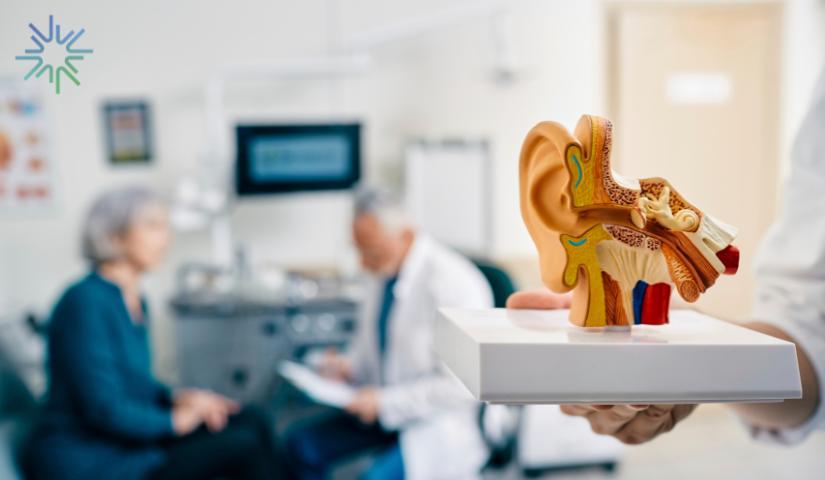Hearing assistive technologies are often seen as a marvel of modern medicine, providing access to sound to those with hearing loss. However, many aspects of these intricate devices remain unknown to the general public. We had the opportunity to interview one of Gateway’s esteemed audiologists, Dr. Rachael Purcel, who shed light on the fascinating inner workings and profound impact of cochlear implants and other hearing assistive devices.
Understanding Cochlear Implants: Components and Functionality
Cochlear implants consist of both internal and external components. Rachael detailed the primary parts, including a magnet, an electrode array that is inserted into the cochlea, and a sound processor. The sound processor captures sound from the environment, converting it into electrical signals. These signals are then transmitted to the internal components via the magnet.
The electrode array plays a critical role. It is surgically inserted through an incision made behind the ear. This array is placed under the skin and into the middle ear space, reaching the cochlea. Importantly, as Rachael emphasized, this procedure does not involve the brain, ensuring it remains a relatively safe operation.
How Cochlear Implants Work
Cochlear implants are designed primarily for individuals with sensorineural hearing loss, which affects the cochlea and the auditory nerve. Unlike traditional hearing aids that amplify sound, cochlear implants work by directly stimulating the auditory nerve with electrical impulses. This stimulation allows the brain to perceive sound, providing a significant improvement in hearing for those with profound hearing loss.
Rachael shared her personal journey and insights, stating, “My residency was actually at a cochlear implant clinic. I worked with a neurotologist, so I saw a lot of different things, but mostly cochlear implants. I got to see a lot of different medical reasons for hearing loss, not just like, simply age-related hearing loss, but a lot more complex conditions. I actually came into audiology through Gallaudet University, which is famously the Deaf university. Initially, I had mixed feelings about cochlear implants, especially given the big feelings within the Deaf community. But then I started learning about them and realized there is a space where both perspectives can coexist. Effective communication is good communication, whether through sign language, hearing aids, or cochlear implants.”
Bone Conduction Devices: An Alternative Solution
In addition to cochlear implants, Rachael also discussed bone conduction devices. These devices offer an alternative for those with conductive/mixed hearing losses or single sided deafness (SSD). Unlike cochlear implants, bone conduction devices use the patient’s existing cochlear function and directly stimulate the cochlea through bone conduction. Cochlear implants take it a step further and directly stimulate the auditory nerve through electrical impulses in the cochlea via the electrode array.
Medical vs. Social Models of Deafness
Rachael highlighted the historical and cultural complexities surrounding cochlear implants within the Deaf community. “There was a very big oralism movement, akin to ableism, where people believed that hearing was superior to deafness. Many in the Deaf community were forced to communicate only verbally, often being denied the use of sign language. Cochlear implants were seen by some as a way to ‘fix’ Deaf people, which led to significant pushback. The medical model views cochlear implants as a solution to a non-functioning cochlea. But from a social perspective, the focus should be on communication access. It’s not about fixing a person but providing tools for effective communication.”
Rachael emphasized, “I work with signing patients all the time. For many, their main goal is not speech, but effective communication. Hearing aids and cochlear implants are tools that can enhance environmental awareness and safety, not necessarily replace sign language. If the implant is removed, the person still has hearing loss. It doesn’t change who they are; it provides a tool for better awareness and aid in verbal communication.”
The Importance of Personalized Care and Accessibility
One of the key takeaways from our conversation with Rachael was the emphasis on understanding patients’ communication goals. Every individual has unique needs and aspirations when it comes to hearing and communication. Ensuring that these goals are met with the appropriate technology is paramount. Accessibility and effective communication remain at the forefront of Gateway’s mission, and Rachael highlighted the importance of making these technologies available and understandable to all.
She concluded, “Cochlear implants and hearing aids should be seen as tools for communication and access to sound. There’s been less pushback over time, with more acceptance of combining cochlear implants with sign language. But it’s crucial to respect each individual’s choice and communication needs.”
Cochlear implants and bone conduction devices are transformative technologies that can significantly enhance the quality of life for individuals with hearing loss. However, their effectiveness hinges on personalized care and a deep understanding of each patient’s unique needs. At Gateway, we are committed to providing comprehensive support and education about these life-changing devices.
We hope this deeper look into the world of cochlear implants, guided by the insights of our dedicated audiologist Dr. Rachael Purcel, helps demystify these remarkable technologies and highlights the incredible potential they hold for improving communication and connectivity.
For more information about cochlear implants and other hearing solutions, visit our website or schedule a consultation with one of our expert audiologists today.
by Emilie Aguilar
Learn More About Gateway
Gateway connects people to their worlds and aids individuals in their ability to understand and to be understood. Gateway has grown into an organization that serves more than 4,000 children and adults every year, helping them communicate more effectively. With programming both on our Baltimore campus and through community-based programming, we provide education, access, and medical support to anyone who needs it.
We envision a society where everyone can understand and be understood and where everyone is treated with integrity, compassion, and equity.



